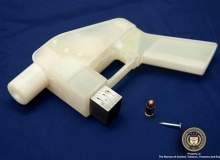
Ever since the first 3D printed, all-plastic gun was fired back in May 2013, there have been fears that the technology could soon end up in the hands of criminals and terrorists.
Although the US State Department swiftly ordered makers Defense Distributed to remove digital blueprints for its pioneering handgun, the Liberator, other designs are freely available on the internet as ‘open-source’ content, so anyone who has access to the internet and a 3D printer, could easily become an arms manufacturer.
It’s a new paradigm that law enforcement agencies are extremely worried about. Firearms could become much easier to get hold of and, in a worst-case scenario, a 3D printed gun could slip through traditional metal detectors in high-security areas like airports or government buildings.
How well do you really know your competitors?
Access the most comprehensive Company Profiles on the market, powered by GlobalData. Save hours of research. Gain competitive edge.

Thank you!
Your download email will arrive shortly
Not ready to buy yet? Download a free sample
We are confident about the unique quality of our Company Profiles. However, we want you to make the most beneficial decision for your business, so we offer a free sample that you can download by submitting the below form
By GlobalDataOne company based in the ‘cyber valley’ in Western England thinks it has an answer. Radio Physics Solutions, which designs scanners and detectors for the security industry, is planning to produce the first-ever scanner capable of detecting a concealed 3D printed gun.
See Also:
The device can also detect traditional metallic weapons and person-borne IEDs (PB-IEDs) used by suicide bombers.
Unlike current systems, this revolutionary technology does not use X-rays or require a person to walk through a special area to be searched; instead it works more like a radar gun used by the police to catch speeding motorists. Operators simply point the device at individuals and,with the aid of extremely high frequency radio waves, can ‘see’ through obstacles and clothing.
Is 3D printing a breakthrough manufacturing process for weaponry, or just a way for criminals to bypass official acquisition processes?
Radio Physics Solutions says the device does not infringe on a person’s privacy.
First-ever viable standoff weapon detector
There are currently two variants of the detector,;one that is handheld for mobile use (MiRLIN) and another, larger device (MiRTLE) which is tripod-mounted and is capable of scanning people from up to 25m away.
Tests this month conducted by the UK’s National Ballistics Intelligence Service (NABIS) showed the scanners could detect a composite, non-metallic weapon and alert an operator ‘in less than one second’.
"This is the first viable and operational standoff weapon detector we have seen," said Clive Robinson at NABIS. "We introduced firearms into several personal concealment scenarios, and on each occasion the RPS detectors alerted the operator to the presence of a concealed threat on both static and moving subjects."
The detectors use in-built artificial intelligence to analyse radio waves in real-time. If a threat is detected, the device will alert the operator on a full-colour display with a colour-coded cursor which highlights the suspected area. It works because objects like firearms or bombs present different radar signatures compared with everyday items like mobile phones or keys.
This revolutionary technology could be a vital asset for law enforcement agencies and security forces around the world says Douglas Dundonald, chairman of Radio Physics Solutions and founder of investment company Anglo Scientific.
"You talk to police forces worldwide and gun crime is a significant issue," says Dundonald. "If you can detect – without having to stop and search somebody – whether someone is carrying a gun then that’s very valuable. It will have a positive impact because you won’t have to search so many people and you can narrow down who you search."
"In terms of person-borne IEDs, in many parts of the world that is a major issue and unfortunately it’s becoming a bigger issue in many more parts of the world than it was 10 years ago. The ability to detect in a crowd, or public place is, again, very valuable and should reduce loss of life significantly," Dundonald adds.
The detectors use technology originally developed by Professor Nick Bowring and a team of engineers at Manchester Metropolitan University. Both the Home Office and the Metropolitan Police have previously funded the project to refine the technology.
Reviewing Sochi’s security solutions, international support and what the legacy may be for Russia’s security forces .
Crowdfunding: raising money in the global village
Last year, Radio Physics Solutions agreed terms to license the technology and begin to commercialise the product for security forces and law enforcement agencies to purchase.
In a unique initiative, Radio Physics Solutions is turning to crowdfunding to help mature the detector technology. It is seeking £600,000 by selling equity through crowdfunding site Syndicate Room.
Investors have already pledged £380,000 and the remaining equity is open to anyone willing to invest more than £1,000. Dundonald says the principle advantage of crowdfunding is not necessarily just raising capital.
"We think crowdfunding platforms are a very interesting way of informing a wider audience of what you’re doing," says Dundonald. "When you’re trying to build a business that has global applicability it’s much better to try and raise money from that global village and expose yourself to a much wider audience."
Radio Physics Solutions is hoping to raise enough capital to realise the full potential of the technology and make it a market-leading product comparable to conventional scanners today. With the ability to detect the growing threat from 3D printed weapons, it has the potential to do just that.
Follow Grant Turnbull on Google+


.gif)



